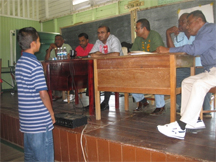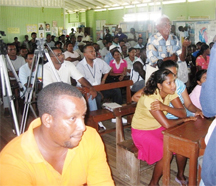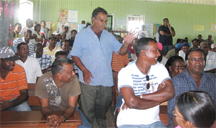In light of the current dry conditions, President Bharrat Jagdeo has encouraged farmers in the Mahaicony area to look at diversification as a long term solution so that they can survive during the “toughest times.”

During the meeting with the farmers yesterday at the Mortice Primary School, the president said government would assist with the diversification programme “because ultimately we want you to get more income from your work.”
He told the farmers that they should be involved in a series of activities, including rice, cattle farming and aquaculture which would make them less reliant on the weather.
Also addressing the farmers were Minister of Agriculture, Robert Persaud, Regional Chairman of Region Five, Harrinarine Baldeo, Chairman of the Mahaica-Mahaicony-Abary (MMA) board, Rudolph Gajraj and General Secretary of the Rice Producers Association, Dharamkumar Seeraj.
Residents expressed gratitude to the president for the completion of the Mahaicony Branch road which was constructed with asphalt at a cost of $200M.
They also asked for the road to be extended by a further two miles to Mora Point even if it is with “burn brick” so that there would be easier access especially to the health centre located in the creek.
The president promised to look into the request.

Meanwhile, some farmers are happy with the Perth/Biaboo irrigation canal that is being constructed by the MMA on the left bank of the Mahaicony Creek but others said they are being affected by it.
One man complained that his fruit and provision farm which was on his transported land had to be destroyed so that the canal could pass through but said the MMA did not consult first nor was he compensated. Jagdeo agreed that there should be discussions with persons in such cases while an inventory ought to be done of the trees and if the land is transported government must provide compensation.
Other concerns regarding the canal were raised and the president said that a final meeting would be held with the farmers on Thursday so that a consensus could be reached.
The residents also complained about an inadequate water supply and the president announced that the Minister of Water, Irfaan Ali would be visiting to deal with the problem.
A boy bravely made a request for the sports ground in the area to be developed and for the provision of sport gear which the president agreed to but asked for a club to be formed.
Mixed fortunes
Jagdeo said there seems to be mixed fortunes in the agricultural industry with farmers suffering from floods almost every year. Because of that, over the last ten years the country lost the equivalent of an estimated 10% of its gross domestic product, amounting to US$120M per year.

He said government is taking several steps to address the situation, such as empoldering of land, development of drainage and irrigation and the commitment of a $3B canal at Hope, East Coast Demerara.
The canal would assist with the discharging of water from the East Demerara Water Conservancy (EDWC) into the Atlantic in case the dam is threatened.
The designs are ready and this year there would be major implementation of the project which the president said would take more than a year to complete.
He said he was advised by the engineers that the project was “technically feasible” as water would no longer have to be released from the EDWC via the Lama and Maduni sluices which resulted in residents of the Mahaica, Mahaicony and Abary being affected.
Government has already bought more than $400M worth of equipment to start the project which would take more than a year to complete because of the construction of a huge koker, roads and bridges.
He said it was a big financial commitment but it has to be done to address the excessive rainfall. To deal with the drought, he said, emergency measures had to be taken such as the digging of more irrigation canals.
With regard to the rice industry, the president said although there was massive production last year, the prices were low. Unless new markets are secured, government would not be able to substantially maintain prices.
Jagdeo was pleased that Venezuelan president, Hugo Chavez has agreed to purchase some of the rice and he hopes that it develops into a bigger market.
He said too that in other countries some farmers are “growing different types of rice based on hybrid seeds that gives them 15 tonnes per hectare” compared to the 4.6 tonnes per hectare in Guyana. He also urged the farmers that they can focus on getting their yields up in order to double their production.
The president recently allocated $400M to the rice industry which would be used for fertilizer and a drying facility for the farmers. He mentioned that the capacity for government to assist has increased tremendously as the country has developed and the economy and revenues have grown significantly.
He said 230 roads were awarded to be constructed this year and by the end of the year there would be some 630 community roads on the coast under construction.
An expansion of the four-lane main road on the East Bank would be done all the way to Diamond because of development in that area.
The East and West Canje roads are also being built while a large sum would also be spent on the Black Bush Polder road. The president said proudly that six hospitals were built while government has sent over 1000 students abroad to study.
This year, he said a school-feeding programme, costing some $800M per year would be introduced at all the schools. Students in the interior would have “hot meals” while those on the coast would benefit from biscuits and juice.
There would also be an expansion of the uniform project so that every child can benefit. He said the projects are possible because government has “greater capacity now to spend.” He pointed out that the external reserve [in the Central Bank] is US$650M.
Meanwhile he reiterated that $1B has been set aside “to support a mangrove growing, tree planting and maintenance exercise because if we don’t repopulate our entire coast with mangrove then it would be just too expensive to build structures to keep the sea out.” Observers note that a project of this type will suit the Low Carbon Development Strategy although some skepticism has been expressed about if it can work.



